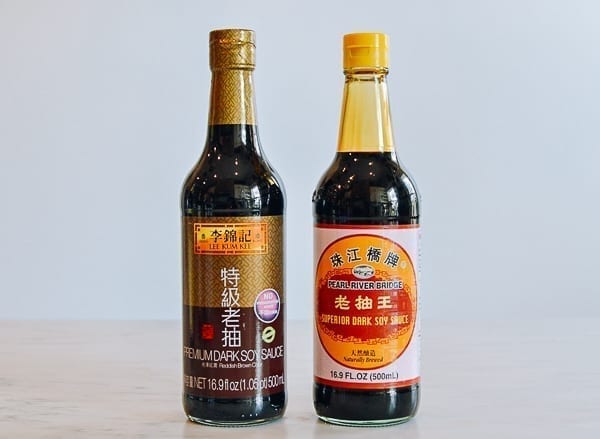What is Dark Soy Sauce?

Dark soy sauce is a fermented seasoning that originated in China but has since spread throughout Asia and become a common ingredient in various cuisines. While dark and light soy sauces may seem similar, there are notable differences between the two that are worth exploring.
Dark Soy Sauce
Let’s take a deeper dive into the history, production process, flavors, uses, pairings and health benefits of this delicious condiment.
Origins and History
The earliest documentation of fermented soybean sauces dates back to the Western Han Dynasty in ancient China between 206 BC to 24 AD. Scientists believe that dark soy sauce’s beginnings can be traced to fermented black soybeans, which are still used as an ingredient today. Over subsequent centuries, Chinese traders spread soy sauce production methods throughout East and Southeast Asia.
Japan embraced soy sauce, or “shoyu” as they call it, and Japanese variations evolved with local production techniques and wheat additions. The Japanese are credited with developing the darker, richer variety through longer fermentation periods. Dark soy sauce is known as “taucheo” in Malaysia and Indonesia, where it also took root due to colonial trades. By the 17th century, soy sauce had become a ubiquitous condiment throughout much of Asia.
Production Process
Traditional dark soy sauce is still produced through a natural fermentation process. Quality ingredients like non-GMO soybeans and wheat are soaked and cooked before being inoculated with Aspergillus mold cultures. This starts the breakdown of proteins into amino acids and carbohydrates into sugars.
The mash then undergoes a multi-month aging process where temperatures and humidity are carefully controlled. Beneficial bacteria and yeasts further hydrolyze components, producing new flavors and darkening the color. Some modern producers will add caramel coloring or molasses to speed this stage. Once fully fermented, salt is blended in for preservation before bottling.
Flavor and Aroma Profile
Visually, dark soy sauce is much darker than the lighter variety, ranging in hue from deep brown to almost black. On the palate, it delivers an intensely savory and umami-rich experience. Complex notes of molasses, roasted nuts, and charred meat emerge alongside an underlying sweetness. Full-bodied with a viscosity that coats the mouth, it leaves a long-lasting, lingering finish.
Uses in Cooking and Pairings
A few tablespoons of dark soy sauce is commonly used to add depth and complexity when cooking meats, fish, tofu or vegetables. It acts as a flavorful marinade ingredient and is also great for braising, glazing or in stir-fries. Due to its robust nature, less is needed compared to lighter soy sauce. It pairs exceptionally well with red meats, duck, game, mushrooms and heartier greens. The natural blend of flavors enhances salmon, shrimp and firm white fish too.
Tips for Using Dark Soy Sauce
- Start with a small amount and add more to taste when cooking. A little goes a long way due to its potency.
- Store soy sauce away from heat sources or direct sunlight to prevent quality deterioration. A cool, dark cupboard is ideal.
- Stir well before each use as solids settle over time.
- Experiment using dark soy sauce in marinades for meat or tofu before grilling or roasting.
- Try mixing equal parts dark soy sauce with rice vinegar or lemon juice for a quick dipping sauce.
- Use as a finishing glaze brushed onto meat, fish or vegetables during the last few minutes of baking or broiling.
Health Benefits
Research indicates that fermented foods like soy sauce contain beneficial bacteria, digestive enzymes and antioxidants not found in their pre-fermented forms. Soybeans and wheat provide proteins, vitamins, minerals and plant compounds in dark soy. Studies show these support heart, brain, bone and gut health. Traditional preparation creates probiotics and allows for greater bioavailability of nutrients too. Due to its strong savoriness, using dark soy sauce can also help reduce overall salt intake.
Storage and Alternatives
Properly stored in a cool, dark place away from heat and light, high-quality dark soy sauce will maintain freshness for 12 months or longer after opening. If settling occurs, simply stir to reincorporate solids. For those looking to substitute, there are many substitutes for dark soy sauce. Use regular soy sauce with 1⁄2 teaspoon molasses or try Worcestershire or hoisin sauce for their comparable rich and complex profiles.
Conclusion
In closing, dark soy sauce deserves recognition as more than just a simple condiment. Its coveted flavors developed through skilled preparation enrich countless Asian dishes. With a bold yet nuanced taste, this fermented seasoning showcases the transformative power of traditional aging processes on plant proteins. Those interested in bringing more depth, intrigue and culinary heritage into home cooking would be wise to explore the versatility of dark soy sauce.
For more, check the rest of our blog.
__________________________
Frequently Asked Questions
Is dark soy sauce suitable for vegetarians and vegans?
Yes, traditional dark soy sauce is suitable as it is made only from fermented soybeans and wheat without any animal products. However, check ingredients in case of additives.
Can I substitute dark soy sauce in recipes calling for light soy sauce?
Yes, but use slightly less (about 3/4 amount) due to its richer flavor. Add a dash of sugar, rice vinegar or water if a lighter profile is needed.
What other ingredients are commonly added to commercial soy sauces?
Sugar, salt, caramel color, roasted grain or corn extract are often included for flavor and color enhancement. Check labels to read actual ingredients.
Does soy sauce expire, and how can I tell if it has gone bad?
Properly sealed soy sauce typically lasts 1–2 years. Signs it may be spoiled include mold growth, changes in color, texture, or smell (sour, yeasty or ammonia scent). Discard if in doubt.
Can dark soy sauce be used in place of tamari or Worcestershire sauce?
While sharing similarities, tamari and Worcestershire sauce have distinct profiles. Tamari is gluten-free, but darker soy sauce can work. Worcestershire adds hint of anchovy – use less soy sauce and add fish sauce.




